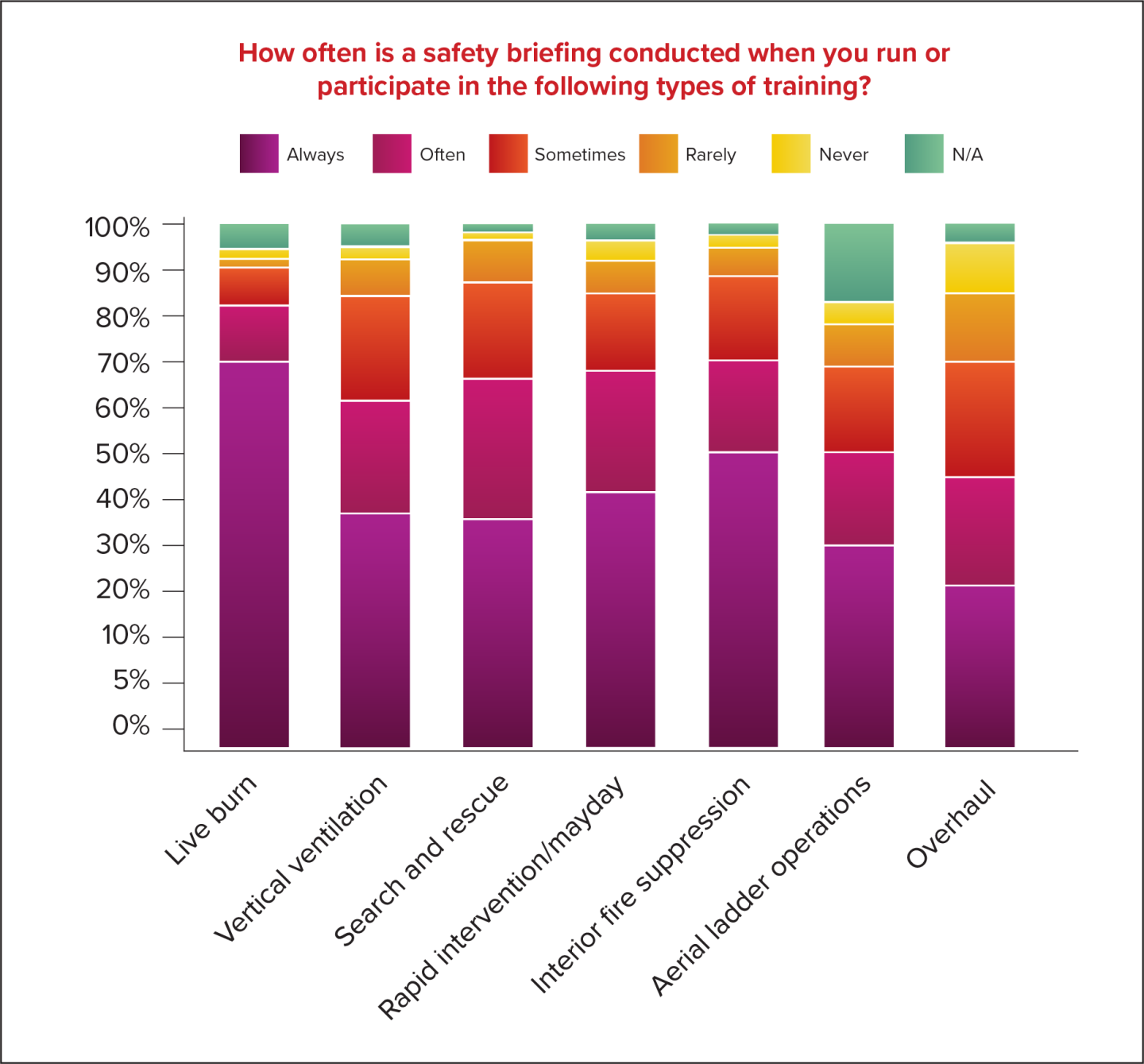Editor’s Note: Download your copy of the What Firefighters Want in 2025 special report, detailing responses to the state-of-the-industry survey focused this year on the intersection of aggressive tactics and safety culture.
I get it — we hear a lot about safety these days. The proverbial safety horse has been kicked, beaten and then kicked again, and some of our brothers and sisters are done hearing about the risks and dangers of typical fireground tasks. And while some argue our safety measures are overkill (a topic debated in several other What Firefighters Want analyses this year), one safety-focused action is simply a no-brainer. An appropriately conducted safety briefing can be an invaluable training tool and, of course, an essential reminder to members about potential issues that could arise during the drill.
But how often are safety briefings being conducted before training? That’s one of the many questions FireRescue1 posed in this year’s What Firefighters Want survey, focused on safety culture and aggressive tactics. More than 1,600 active firefighters responded. Here’s the breakdown:
Live-fire training
As you can see from the chart, live burns had the highest percentage (71%) of respondents who reported that safety briefings were always conducted. Considering the dangers associated with live-fire training, it’s great to see the highest percentage land there. But let’s consider the other side.
NFPA 1403: Standard on Live Fire Training Evolutions states in section 4.1.1 that “strict safety practices shall be applied to all structures selected for life fire training evolutions.” And section 4.3.1 notes that safety training shall be provided to all students prior to being permitted to participate in live fire training. What’s more, section 4.16.2 states “prior to conducting actual live fire training evolutions, a pre-burn briefing sessions shall be conducted by the instructor-in-charge with the safety officer for all participants.”
So, 29% of respondents are not receiving an NFPA 1403 safety briefing before live-burn training — that’s a lot of firefighters going into live-fire training without the knowledge of basic safety principles, escape plans or even what to do in the event of an emergency.
Why are some instructors skipping the safety briefing? As an instructor myself, the only reason I can see is laziness. Instructors cannot become complacent; we must be resolute in our conviction to provide safe and effective training.
Furthermore, in addition to keeping members safe, instructors can use the pre-burn briefing to discuss fire behavior, tactics, line selection — really all major factors impacting the fireground. For example, rather than just explaining the terminal objectives (which is also necessary), question students as to why the 1¾-inch handline works as it does, what to do when encountering high-heat/low-visibility conditions (flow water), the key factor involved in cooling locations as you move and related operations . Use real-life examples of recent fires to enhance their training burns and provide a better experience for the students.
Perhaps not surprisingly, interior fire suppression had the second-highest percentage of respondents report always having a safety briefing — 50%. The same types of training opportunities used for live-fire training can be used for interior fire suppression. But again, that means that 50% of our students are receiving nothing, and that is unacceptable.
Mayday training
A mayday is one of the most dangerous and chaotic events that can happen on the fireground. A member who is trapped or lost is nothing to be flippant about. Therefore, we must train for these types of emergencies on a regular basis. Unfortunately, based on the data, nearly 60% of respondents do not have consistent safety briefings prior to mayday training.
Firefighters participating in mayday training need to know about safe lifting practices, safe drags, proper firefighter size-up, air-management and several other facets to firefighter packaging and evacuation. If you are also incorporating ladder rescues, ropes or other ways to remove a firefighter, then those hazards must be discussed prior to training.Firefighters need to know if there is a “safe word” to be said if they are injured so that others don’t confuse a simulated mayday with an actual mayday.
Vertical ventilation training
As for other types of training, only 37% of respondents reported always having safety briefings before vertical ventilation training, and 12% report rarely or never having them. Most respondents fell in the middle — 24% report often and 21% report sometimes.
When briefing for vertical ventilation, take the time to review the saw operations, how the brake works and best practices for operating on the roof. Discuss fire behavior, vent-point ignition and how visibility can be affected when working on the roof, especially if wind directions change, plus the importance of having keen situational awareness so members don’t inadvertently walk off an edge. Highlight ladder placement, roles and responsibilities of truck company members, and review any relevant standard operating procedures or guidelines unique to their department.
Search and rescue training
When it comes to search and rescue training, 36% report always having safety briefings, with 13% reporting rarely or never. Again, most fell in the middle — 28% report often and 22% report sometimes.
Instructors, use the safety briefing time to emphasize the importance of the thermal imaging camera, review how to remain oriented inside of the building, and address fire behavior dynamics. Discuss the importance of isolating space and reading smoke, and dig into what is actually dangerous and what is perceived to be dangerous. You can stop the fear mongering and sensationalism around what some would deem “high-risk tactics” and ground the members in understanding that window-initiated searches are not dangerous, at least no more than traditional search operations through the front door. Finally, highlight proper drags and carries, backed by new studies and science from UL’s Fire Safety Research Institute.
Don’t miss an opportunity
The safety briefing can, and should, be used for more than just simple safety reminders. While firefighter safety is vital, many firefighters are very aware of the risks associated with fireground training and tasks. Therefore, instructors should use the safety briefing for more than just safety — make it an educational session. Quiz students on scenario-based situations, like how to remove victims or what they can read in the smoke. Allow students to think through problems, not simply be told how to mitigate issues. Carve out time to review policies, procedures and experience from actual calls related to the drill.
100% is best
Firefighters should report receiving a useful and meaningful safety briefing 100% of the time, not just because it is written into an NFPA standard, but because it allows for students to grow, to be reminded of potential issues, and to ultimately make firefighters more effective at their jobs. Let’s make the fire service better together, and this begins with preparing our firefighters for the realities of the job, not with fear, but with facts and data. Keep training!
WATCH | Selective attention is real: 5 tips to increase situational awareness on scene
This article, originally published in August 2025, has been updated.




